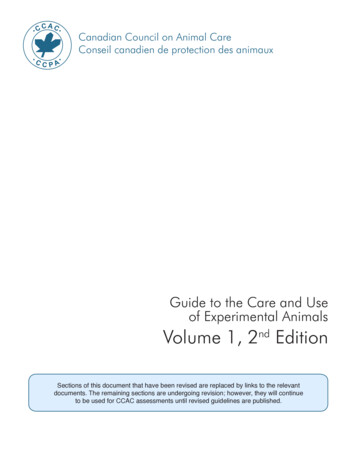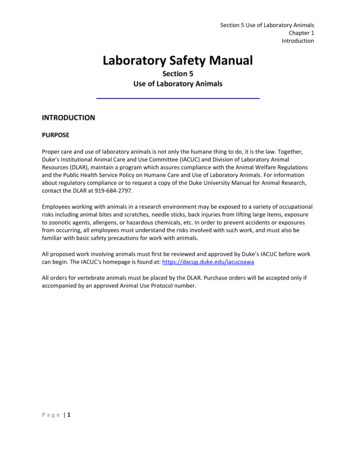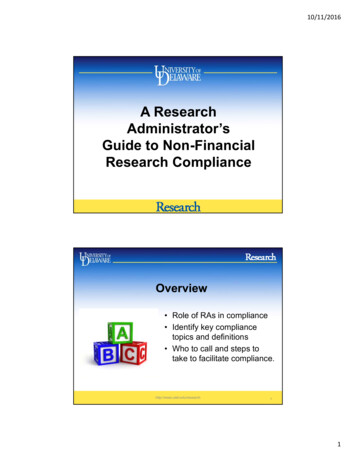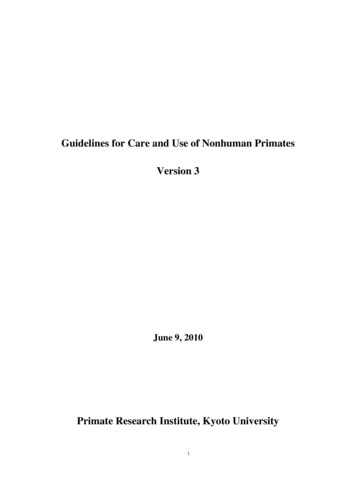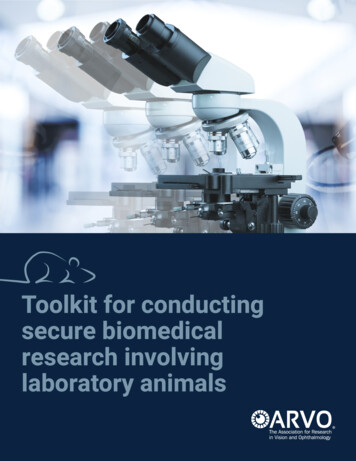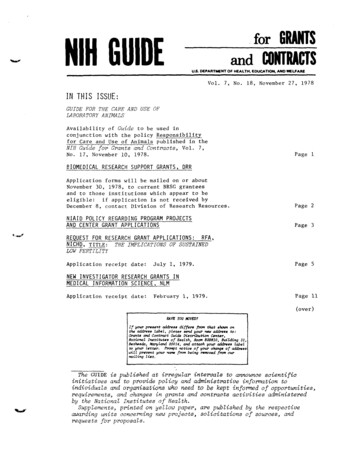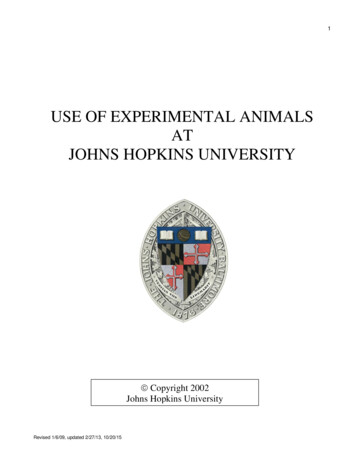
Transcription
1USE OF EXPERIMENTAL ANIMALSATJOHNS HOPKINS UNIVERSITY Copyright 2002Johns Hopkins UniversityRevised 1/6/09, updated 2/27/13, 10/20/15
2CONTACT INFORMATION 4Research Animal Resources .4Molecular and Comparative Pathobiology . .4Comparative Pathology .4Animal Care and Use Committee .4LAWS & REGULATIONS APPLICABLE TO RESEARCH UTILIZINGANIMALS.6Animal Welfare Act . 6Public Health Service Policy on Humane Care and Use of Laboratory Animals. 6Association for the Assessment and Accreditation of Laboratoy Animal Care .7U.S. Government Principles For Use of Animals . 7INSTITUTIONAL REVIEW OF ANIMAL PROTOCOLS . 8GRANT SUBMISSION ANDREVIEW.8TRAINING IN ANIMAL CARE AND USE . 10OCCUPATIONAL HEALTH AND SAFETY IN ANIMAL CARE AND USE . 12Safety Resonposibilities .12Animal Exposure Surveillance Program Overview .12Identification and registration of individuals at risk . 13Hazards associated with working with animals 13Physical hazards .14Biologic Hazards .16Zoonotic Diseases 17Chemical Hazard .20Research Registration Programs .21Incident and Injury Reporting. 21Medical Emergency . 21Emergencies . 22ANIMAL EXPOSURE SURVEILLANCE PROGRAM .22RESEARCH ANIMAL RESOURCES . 26Sources of Research Animals . 26Animal Purchasing Procedures . 27Charge Authorization And Billing . 28Animal Housing and Costs . 28VETERINARY MEDICAL AND ANCILLARY SERVICES. 28Technical Services . 29Clinical Medicine . 29Pathology . 29Support Services . 29Pre-Research Consultation . 30Revised 1/6/09, updated 2/27/13, 10/20/15
3SURVIVAL SURGICAL PROCEDURESANIMAL SURGERY SUITES .31Amphibians. Error! Bookmark not defined.Cats . Error! Bookmark not defined.Chickens and other Avian Species . Error! Bookmark not defined.Chinchillas . Error! Bookmark not defined.Dogs . Error! Bookmark not defined.Ferrets . Error! Bookmark not defined.Fish . Error! Bookmark not defined.Gerbils . Error! Bookmark not defined.Goats/Sheep . Error! Bookmark not defined.Guinea Pigs . Error! Bookmark not defined.Hamsters . Error! Bookmark not defined.Mice . Error! Bookmark not defined.Nonhuman Primates . Error! Bookmark not defined.Pigs . Error! Bookmark not defined.Rabbits . Error! Bookmark not defined.Rats . Error! Bookmark not defined.PURCHASE OF CONTROLLEDDRUGS .ERROR! BOOKMARK NOTDEFINED.ASSESSMENT OF PAIN IN LABORATORY ANIMALS. 32Signs of Pain in Different Species .33Pain Scoring .35PROCEDURES IN COMMON LABORATORY RODENTS ANDRABBITS .36Mice . 36Rats . 41Hamsters . 45Gerbils . 45Guinea Pigs . 45Rabbits . 46AGENTS AND METHODS OF EUTHANASIA BYSPECIES .48FORMS .49SUGGESTED READINGS . 56Revised 1/6/09, updated 2/27/13, 10/20/15
4Research Animal Resources410-955-3273 Clinical calls for veterinary services Technical assistance Transportation of animals Health CertificatesThe Research Animal Resources office is open Monday through Friday from 8:30 a.m. until 5:00 p.m. The office isclosed on weekends and all university holidays. After hours, leave an appropriate message in the voice mailsystem and the call will be returned as soon as possible. If you need veterinary assistance after hours, call theveterinary on-call pager: 410-283-0929Associate Provost for Animal Research and Resources – Robert J. Adams, DVMDirector of Research Animal Resources – Robert J. Adams, DVMAttending Veterinarian – Robert J. Adams, DVMDirector of Laboratory Animal Management – Lindsay Barnes, BS, LATGMolecular and Comparative PathobiologyLaboratory Animal Medicine Research collaboration Academic programs Financial Manager Administrative -9783410-955-9767Director of Molecular and Comparative Pathobiology – Joseph Mankowski, DVMComparative PathologyComparative Pathology Diagnostic necropsy Research fter 5 PM and on weekends and holidays, call the pathologist on call at 410-294-6220.Animal Care and Use CommitteeAll studies, courses or training programs proposing the use of animals must be approved by the Institutional AnimalCare and Use CommitteeOffice web.jhu.edu/animalcareResearch Animal ResourcesAll laboratory animal resources of Johns Hopkins University are administered by Research Animal Resources(RAR) an operational arm of the JHU Provost’s Office with campus-wide responsibilities for animal care and use.Research Animal Resources evolved from Animal Services, a branch of the Department of Molecular andComparative Pathobiology. A strong association continues between the RAR with the Department of Molecular andComparative Pathobiology. RAR veterinarians perform their scholarly activities in JHU’s research and instructionalprograms through their academic appointments in the Department of Molecular and Comparative Pathobiology.Facilities included under RAR’s supervision are located in the School of Medicine, Bloomberg School of PublicRevised 1/6/09, updated 2/27/13, 10/20/15
5Health, Research Farm, Bayview Medical Center, Homewood campus and The Johns Hopkins Hospital complexincluding the Cancer Research Building. Our program for the care and use of laboratory animals is accredited bythe Association for the Assessment and Accreditation of Laboratory Animal Care International (AAALAC) and theRAR managed facilities meet applicable regulatory guidelines.RAR is responsible for the purchase of all research animals and the care of a majority of animals on the JHUcampus. Animals are housed throughout the University and are maintained by RAR staff. Research AnimalResources is working towards the elimination of a small number of investigator maintained satellite animal coloniesto enhance the uniformity of care and establish central accountability for the animals used in JHU researchprograms. The Research Farm, located 37 miles from the Medical Institutions, houses nonhuman primates sociallyin breeding groups for the production of Cercopithecine herpesvirus 1 (B-Virus) free offspring for use in the JHUresearch programs. The service objectives of RAR are to provide humane and scientifically appropriate care for theresearch animals at JHU in compliance with the Animal Welfare Act regulations of the U.S. Department ofAgriculture and with the Guide for the Care and Use of Laboratory Animals. A further institutional objective is toprovide this care as economically as possible through a centralized animal care staff, an institutional pool of cagesand equipment, and wholesale purchase of supplies and equipment.The RAR veterinarians implement the program of veterinary care and provide supervision of the RAR staff toidentify, treat, and prevent intercurrent disease in research animals. The RAR veterinarians perform and/orcoordinate the diagnostic activities for laboratory animal diseases which are provided free to investigators usinganimals under most circumstances due to the recovery of these costs through the per diem recharge system.However, some extraordinary veterinary costs related to conduct of specific experimental protocols may involvecost sharing by the Principal Investigator responsible for the project. Major areas of faculty expertise are in thefields of clinical laboratory animal medicine, retrovirus biology and comparative pathology. RAR veterinarians areavailable for consultation on animal research protocols, laboratory animal management, and development of grantapplications proposing the use of animals. As faculty in the Department of Molecular and ComparativePathobiology, they participate in the teaching of medical students and house staff, as well as graduate andundergraduate students. There are also departmental postdoctoral training programs in the fields of LaboratoryAnimal Medicine, Comparative Pathology and Retrovirus Biology.Research Animal Resources, on behalf of the University, maintains an institutional membership in the AmericanAssociation for Laboratory Animal Science (AALAS). This association publishes the journal, ComparativeMedicine (formerly, Laboratory Animal Science) and The Journal of the American Association for LaboratoryAnimal Science (formerly Contemporary Topics). Contact Research Animal Resources if you are unable to get anarticle from either publication through the Welch library. The Institution also belongs to the National Association forBiomedical Research and the Foundation for Biomedical Research. These organizations act as spokespersons forthe biomedical research community and provide education in the use of animals in research and teaching.Alternatives to Animals in ResearchThe University shares society's concern that animal-based research should be appropriate and use no moreanimals than is necessary. Therefore, all scientists are urged to consider techniques that use minimal numbers ofanimals and are asked if they have investigated alternative methods to animal experimentation at the time ofsubmission of research grant applications and animal use protocols for Animal Care and Use Committee. Anexcellent resource for achieving this goal is ALTWEB.Use of Animals in Teaching LaboratoriesThe University Policy regarding the use of animals in teaching laboratories is that 1) the use of animals in teachingis appropriate, 2) students will not be required to participate in the use of animals in teaching exercises against theirwill, 3) when possible, alternatives to the use of live animals be explored, and 4) the guidelines established by theInstitutional Animal Care and Use Committee should be observed in all courses using animals for teaching.Revised 1/6/09, updated 2/27/13, 10/20/15
6Laws and Regulations Applicable to Research UtilizingAnimalsAnimal Welfare ActScientists and the universities in which they carry out animal-based research or teaching fall under the “AnimalWelfare Act” (7 U.S.C. 2132 et. seq.). The objective of the legislation is to “effectively minimize the pain anddiscomfort of animals while under experimentation”. The Act covers nonhuman primates, dogs, cats, rabbits,guinea pigs, hamsters, gerbils, and aquatic mammals and any other warm blooded animals used for biomedicalresearch. Mice (Mus) and rats (Rattus) bred for research and birds are not covered by the Animal Welfare Act. Inessence, the Act mandates unannounced inspections to ensure compliance with respect to humane care ofanimals used in research, their housing, and medical care including "the appropriate use of anesthetic, analgesic,or tranquilizing drugs, when such use would be proper in the opinion of the attending veterinarian at the researchfacility." Annual reports are required, which the Department and the Institutional Animal Care and Use Committeestaff prepares on behalf of the university. The Animal Welfare Act regulations (9 CFR Subchapter A, Parts 1, 2 and3) are, for the most part, in congruence with the Public Health Service Policy outlined below. The Animal WelfareAct also mandates an annual review of all research by the Institutional Animal Care and Use Committee andsemiannual inspections of facilities by the Committee. In addition, procedures that may cause more thanmomentary or slight pain or distress to the animals require a written narrative description of the methods andsources (e.g., the Animal Welfare Information Center of the National Agricultural Library) used to determine thatalternatives to these procedures are not available. This narrative is required in the animal protocol, which must besubmitted to the Institutional Animal Care and Use Committee for review and approval. In addition, there must alsobe written assurance that the activities do not unnecessarily duplicate previous experiments. The protocol mustalso describe the qualifications and training of the personnel with respect to the procedures to be performed.These points are all addressed in the instructions accompanying the Institutional Animal Care and use CommitteeProtocol forms.Enforcement of Animal Welfare Act regulations is carried out by veterinary inspectors from Animal Care, UnitedStates Department of Agriculture who make unannounced site visits every year to research facilities. Reports filedby these inspectors are available to the public under the Freedom of Information Act.Public Health Service Policy on Humane Care and Use of Laboratory AnimalsThe Public Health Service policy requires that each institution receiving Public Health Services (PHS) funds (e.g.from NIH) for research involving animals submit detailed information in an Animal Welfare Assurance Statement ofCompliance regarding the institution's program for the care and use of animals. Johns Hopkins University has suchan Assurance on file with the NIH Office of Laboratory Animal Welfare (OLAW).Awardee institutions are required to identify an institutional official who is ultimately responsible for the institution'sprogram for the care and use of animals, and a veterinarian qualified in laboratory animal medicine who willparticipate in the program. Institutions are also required to designate clear lines of authority and responsibility forthose involved in animal care and use in PHS-supported activities.The policy defines the role and responsibilities of Institutional Animal Care and Use Committees and will enhancethe involvement of such committees in all aspects of PHS-supported research at those institutions. The policyrequires that Institutional Animal Care and Use Committees include an individual unaffiliated with the institution, aveterinarian who has program responsibilities and who has training or experience in laboratory animal science andmedicine, a practicing scientist experienced in research involving animals, and a member whose concerns are in anonscientific area.The policy requires institutions to develop mechanisms to review and approve those sections of applications forPHS funds that relate to the care and use of animals (Vertebrate Animals Section) before PHS funds may beawarded.Johns Hopkins University has assured the PHS that all uses of animals for research, testing or instruction will be inaccordance with the Principles outlined below.Revised 1/6/09, updated 2/27/13, 10/20/15
7Association for the Assessment and Accreditation of Laboratory Animal CareInternationalThe Association for the Assessment and Accreditation of Laboratory Animal Care (AAALAC) is a “private, nonprofitorganization that promotes the humane treatment of animals in science through voluntary accreditation andassessment programs”. AAALAC accreditation demonstrates that the facility has met minimum legal standards andhas taken additional steps to achieve excellence in animal care and use.Johns Hopkins University is fully accredited by AAALAC International. To maintain our accreditation, the IACUCsubmits an annual report. This report includes current personnel information and explains any changes that havebeen made to the animal care and use program. Voluntary scheduled site visits are held every three years toevaluate our program and offer advice and suggestions on improvement.U.S. Government Principles for Use of Animals(Federal Register, May 20, 1985, Vol. 50, No. 97, Office of Science and Technology Policy.)These principles were prepared by the Interagency Research Animal Committee. This committee, which wasestablished in 1983, serves as a focal point for federal agencies' discussions of issues involving all animal speciesneeded for biomedical research and testing. The committee's principal concerns are the conservation, use, care,and welfare of research animals. Its responsibilities include information exchange, program coordination, andcontributions to policy development.U.S. Government Principles for the Utilization and Care of Vertebrate Animals Used in Testing, Researchand TrainingThe development of knowledge necessary for the improvement of the health and well-being of humans or animalsrequires in vivo experimentation with a wide variety of animal species. Whenever U.S. Government agenciesdevelop requirements for testing, research, or training procedures involving the use of vertebrate animals, thefollowing principles shall be considered; and whenever these agencies actually perform or sponsor suchprocedures, the responsible institutional official shall ensure that these principles are adhered to:I. The transportation, care, and use of animals should be in accordance with the Animal Welfare Act (7 U.S.C.2131 et.seq.) and other applicable Federal laws, guidelines and policies.II. Procedures involving animals should be designed and performed with due consideration of their relevance tohuman or animal health, the advancement of knowledge, or the good of society.III. The animals selected for a procedure should be of an appropriate species and quality and the minimum numberrequired to obtain valid results. Methods such as mathematical models, computer simulation, and in vitro biologicalsystems should be considered.IV. Proper use of animals, including the avoidance or minimization of discomfort, distress, and pain whenconsistent with sound scientific practices, is imperative. Unless the contrary is established, investigators shouldconsider that procedures that cause pain or distress in human beings may cause pain or distress in other animals.V. Procedures with animals that cause more than momentary or slight pain or distress should be performed withappropriate sedation, analgesia, or anesthesia. Surgical or other painful procedures should not be performed onunanesthetized animals paralyzed by chemical agents.VI. Animals that would otherwise suffer severe or chronic pain or distress that cannot be relieved should bepainlessly killed at the end of the procedure or, if appropriate, during the procedure.VII. The living conditions of animals should be appropriate for their species and contribute to their health andcomfort. Normally, the housing, feeding, and care of all animals used for biomedical purposes must be directed bya veterinarian or other scientist trained and experienced in the proper care, handling, and use of the species beingmaintained or studied. In any case, veterinary care shall be provided as indicated.Revised 1/6/09, updated 2/27/13, 10/20/15
8VIII. Investigators and other personnel shall be appropriately qualified and experienced to conduct procedures onliving animals. Adequate arrangements shall be made for their in-service training, including the proper and humanecare and use of laboratory animals.IX. Where exceptions are required in relation to the provisions of these Principles, the decisions should not restwith the investigators directly concerned but should be made, with due regard to Principle II, by an appropriatereview group such as an institutional animal care and use committee. Such exceptions should not be made solelyfor the purposes of teaching or demonstration.Failure to adhere to these regulations, policies and guidelines could lead to severe sanctions including civil and/orcriminal penalties, loss of funding and university disciplinary action.Institutional Review of Animal ProtocolsProtocol SubmissionResearch activities which use live vertebrate animals require annual review and approval by the Institutional AnimalCare and Use Committee. In order to accomplish this all investigators must submit experimental protocols on theInstitutional review form. Periodically, updates are made to these forms. To prevent delays in processing theprotocol, download and use the newest version of the protocol template from the ACUC website. After approval, thedetailed protocol must be resubmitted and reviewed every three years; abbreviated annual renewal forms must becompleted to assure continued access to animal use in the intervening two years. Requests for significant changesto previously approved protocols must be submitted on the appropriate amendment form. Links to all forms areincluded at the end of this book along with examples of the reminder letters that accompany them. Completedforms should be submitted to the Institutional Animal Care and Use Committee as indicated below.The protocol review forms have been designed to provide the committee with the necessary information toadequately review the proposed animal work. The questions asked are required by both the Federal AnimalWelfare Act regulations and Public Health Service Policy.All Schools:Deadline:Institutional Animal Care and Use CommitteeB122 Reed HallFirst business day of eachmonthNumber of Copies:1Institutional Animal Care Committee approval is necessary for all vertebrate animals used in testing,research, and training in the University. All investigators will be required to provide protocol approvalnumbers at the time of ordering animals or arranging for billing. Amendments must be approved before thenew procedures can be performed. Submission of an amendment is not sufficient; it must go through thereview process and be approved. All individuals involved in the handling or procedures performed onanimals must be included in the protocol.Committee Review of ProtocolsProtocols must be submitted by the first business day of each month in order for the Institutional Animal CareCommittee to review it during the committee’s monthly meeting on the third Thursday of the month. Protocols willbe assigned to individual members of the Committees who will act as primary reviewers. These reviewers willcontact the investigator with any questions or suggestions before the meeting in order to facilitate approval ofprotocols. In this situation, the full committee grants approval for the protocol. Protocols can also be reviewed bythe designated review system appointed by the Chair, who has the authority to approve the protocol, requiremodifications to secure approval, or request full committee review. For additional information on protocols,amendments, change in personnel, etc. contact the Institutional Animal Care and Use Committee.Grant Submission and ReviewThe following general guidelines are applicable in all Schools of the University.In constructing a Public Health Service (PHS) grant application, the principal investigator should include a sectionRevised 1/6/09, updated 2/27/13, 10/20/15
9devoted entirely to vertebrate animal use. After the investigator receives notice from the funding agency thathis/her grant application is likely to be funded, he/she must submit an animal use protocol covering all the activitiesdescribed in the vertebrate animal section for review and approval by the Animal Care and Use Committee. Animalprotocol approval is no longer required prior to grant submission. However, an approved protocol consistent withthe vertebrate animal section is required prior to awarding a grant. Investigators with good priority scores (likelyfundable) on their grants are advised to submit an animal use protocol consistent with the vertebrate animal sectionof their grants as soon as they learn of their scores. This will allow sufficient time to review and approve their animaluse protocols without delaying their funding.PHS Grant Requirements for Use of Vertebrate AnimalsReview of this section is required for all new and renewal PHS grant applications. The grant (Research Plan/orVertebrate Animal Section) should contain all the information that the National Institutes of Health (NIH) hasspecified shall be included in this section, i.e.:a. Provide a detailed description of the proposed use of the animals in the work previously outlined in the researchdesign and methods section. Identify the species, strains, ages, sex, and numbers of animals to be used in theproposed work.b. Justify the use of animals, the choice of species, and the numbers used. If animals are in short supply, costly,or to be used in large numbers, provide an additional rationale for their selection and numbers.c. Provide information on the veterinary care of the animals involved.d. Describe the procedures for ensuring that discomfort, distress, pain, and injury will be limited to that which isunavoidable in the conduct of scientifically sound research. Describe the use of analgesic, anesthetic, andtranquilizing drugs and/or comfortable restraining devices, where appropriate, to minimize discomfort, distress,pain and injury.e. Describe any method of euthanasia to be used and the reasons for its selection. State whether this method isconsistent with the recommendations of the American Veterinary Medical Association Guidelines forEuthanasia. If not, present a justification for not following the recommendations.The vertebrate animal section should contain all the required information (a-e), or it will be deemed incomplete.Other AgenciesApplications for funding from other agencies e.g. American Heart Association, often reflect different policiesregarding Institutional Animal Care and Use Committee review; in many instances certification of committeeapproval must accompany the grant at time of submission.Specific Requirements of Individual Schools of the UniversitySchool of Arts and Sciences:All grant applications and the materials and methods and the Vertebrate Animal Section are reviewed by the Deanof Research and Graduate Education. The vertebrate animal section is compared to the cited approved protocols toinsure that all proposed work has been reviewed and approved by the Institutional Animal Care and UseCommittee. Investigators should provide copies of their approved animal use protocols together with their grantapplication. For further details contact the Sponsored Projects Officer, 237 Mergenthaler Hall (410-516-8841).School of Engineering:All grant applications, the materials and methods and the vertebrate animal sections are reviewed by th
Agriculture and with the Guide for the Care and Use of Laboratory Animals. A further institutional objective is to provide this care as economically as possible through a centralized animal care staff, an institutional pool of cages and equipment, and wholesale purchase of supplies and equipment.


